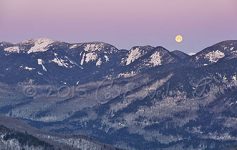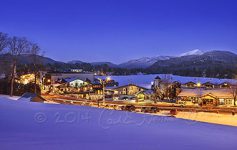This past Saturday, 1/7/12, I headed out to climb Rooster Comb and Snow Mountain in the Keene Valley area with the group that had signed up for the High Peaks Full Moon Photo Tour. In all my years of hiking up here I had never hiked Rooster Comb before, but with all the scouting I did through photos, Google Earth, and with a program I have that sets up lunar schedules and sky locations, I knew the summit of Rooster Comb would be a good place to be when the nearly full moon rose on Saturday afternoon. All we needed was cooperation from the weather.
We met at the parking lot at 9:30, had our introductions, got the gear together, and headed up the trail. Even though there was almost no snow on the ground, it wasn’t long before we were stopping to photograph scenes along the trail. Given the warm day and light thaw, there was a variety of icy patterns in the streams and wet areas, as well as icicles hanging over the rocks and ledges. With the sky being pretty overcast, the light was quite soft and diffuse which made for excellent photography light in the woods along the trail.

Depth of field is often a critical issue when taking a photo. This is true when working with any focal length. The shorter the focal length the greater the depth of field potential. What’s most important though is to understand where to put the actual point of focus in order to maximize the depth of field. I have charts to work with as handouts that detail the range of depth of field at different aperture settings for a variety of focal lengths (this is also in my photo techniques books as well). The actual point of focus (the hyperfocus point) is twice as far away as the closest subject that can be in focus at the given focal length / aperture opening. While this sounds complicated, it’s easier to understand when you see it in practice, and then work with it for a bit.
 All the stops we made for photos along the trail slowed our progress a bit, so when we reached the junction for Snow Mountain, I decided it was best just to head for the top of Rooster Comb. The timing worked out well! Clouds were breaking up, and we had some really nice light over the mountains. The clouds were still hanging over the summits, making for some really dramatic images. We hiked on over to the Valley View lookout before heading on to the actual summit.
All the stops we made for photos along the trail slowed our progress a bit, so when we reached the junction for Snow Mountain, I decided it was best just to head for the top of Rooster Comb. The timing worked out well! Clouds were breaking up, and we had some really nice light over the mountains. The clouds were still hanging over the summits, making for some really dramatic images. We hiked on over to the Valley View lookout before heading on to the actual summit.
 The light was great when we first got to the top, but another bank of really dark clouds was pushing in from the west. After a half hour or so the view with the sunlight on Giant was replaced with a dramatic sky that had a rather ominous look. The dark clouds added a whole different character, but unfortunately blocked any view of the moon rising over the ridge to the north of Giant. The wind picked up as the sky started spitting little snowballs at us, making it feel much more like winter on the exposed ridge.
The light was great when we first got to the top, but another bank of really dark clouds was pushing in from the west. After a half hour or so the view with the sunlight on Giant was replaced with a dramatic sky that had a rather ominous look. The dark clouds added a whole different character, but unfortunately blocked any view of the moon rising over the ridge to the north of Giant. The wind picked up as the sky started spitting little snowballs at us, making it feel much more like winter on the exposed ridge.
 Patience paid off though. The low, fast moving clouds were not a completely solid layer, and as they began to break up, some of the deep blue twilight sky was peeking through. The moon finally made an appearance through one of the openings, and for the next half hour or more we all photographed the landscape with the full moon showing through breaks in the passing clouds. One of the favorite photos I shot that evening was a 30 second exposure that showed the motion of the clouds, but the moon also made a brief appearance during the exposure and put the moon within the exposure range of the rest of the photograph. While the overall weather wasn’t exactly what I had hoped for, in many ways it exceeded my expectations, and gave opportunities for a variety of unique images!
Patience paid off though. The low, fast moving clouds were not a completely solid layer, and as they began to break up, some of the deep blue twilight sky was peeking through. The moon finally made an appearance through one of the openings, and for the next half hour or more we all photographed the landscape with the full moon showing through breaks in the passing clouds. One of the favorite photos I shot that evening was a 30 second exposure that showed the motion of the clouds, but the moon also made a brief appearance during the exposure and put the moon within the exposure range of the rest of the photograph. While the overall weather wasn’t exactly what I had hoped for, in many ways it exceeded my expectations, and gave opportunities for a variety of unique images!





Beautiful scenery!?